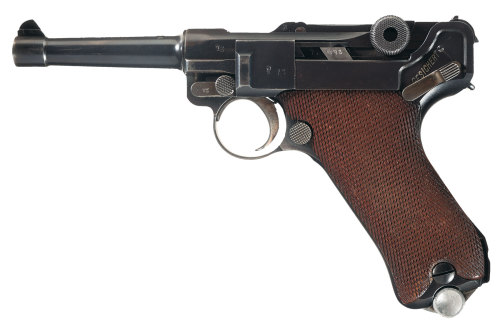Simson 9mm Prototype
Pictured above are two examples of Simson & Co. Waffenfabrik’s 9mm pistol developed in the late 1920s. Simson & Co. had been founded in Suhl in 1856, by Löb and Moses Simson. The company began manufacturing firearms in the late 19th century and during World War One they produced bayonets, rifles, machine guns and engines for the German war effort. The victorious Allies banned German military firearms manufacture in 1919, this continued into the 1930s. Simson & Co., however, won a lucrative contract to manufacture the limited number of parts that the German army and police required for the refurbishment and maintenance of their Luger P08s. In 1925, the company was contracted to manufacture 10,000 new P08s, the only German small arms company to be permitted to do so by the Disarmament Commission.

Simson & Co. Suhl Luger pistol (source)
At the same time Simson & Co., like many other German firearms companies, produced small, non military calibre, pocket pistols. The first of these was the Model 1922, a small blowback pistol with a rounded frame, chambered in 6.35mm (.25 ACP) with a 6-round magazine. This was followed in 1926/7 by a slightly modified modified version which had flat frame making it cheaper and easier to manufacture. Simson & Co.’s pistols were good quality and sold fairly well.

A 1926 second model Simson & Co. 6.35mm pocket pistol (source)
In the late 1920s, Simson & Co. began work on a new blowback design chambered in the restricted 9mm military calibre. Some sources date the pistols to 1929, around this time the German Heer (army) were beginning to consider designs for the replacement of the P08. Both Mauser and Walther worked on 9mm pistols in secret without the knowledge or approval of the Disarmament Commission. One hypothesis is that the Simson & Co. prototypes were also designed with the Heer in mind. Another is that they were developed for the Prussian police, who eventually adopted the Luger.
The pistols themselves combine the flat frame and general layout of Simson & Co.’s second model pocket pistol with the grip of the Luger. The pistol had a large frame mounted safety lever on the left side of the weapon. It used modified Haenel-Schmeisser patent P08 magazines which held the standard 8 rounds. Interestingly the pistol had a heel magazine release rather than the Luger’s thumb release. Despite this the advantage of retaining Luger magazines would be that the Heer simply had to modify its existing stocks of magazines. On top of the pistol is a large loaded chamber indicator just behind a centrally positioned ejection port. The pistol was striker fired and used a blowback action with a strong recoil. 9mm parabellum is a little too powerful for a straight blowback action, this was something Walther discovered later with the Militarpistole. It is unlikely that the German military would have adopted a blowback 9mm and extensive testing may have highlighted issues. It was hoped, however, that this simpler blowback system would significantly decrease the cost of production making the gun more appealing to Heereswaffenamt (German Ordnance). Following some cursory testing the Heereswaffenamt decided that submachine gun development and the production of the K98k (adopted in 1935) were more pressing and the search for replacement for the Luger was halted for several years.
It is unclear how many of the 9mm pistols were made, however, at least two survive - with subtle differences between the two. The pistol’s squared off frame and slide combined with the Luger grip angle give the prototype pistols a striking and quite modern appearance. As the Nazi party came to power and the persecution of Germany’s Jews began Simson & Co. became a target and after being imprisoned Arthur Simson, the then-owner of the factory, was forced to sign over ownership to a Nazi trustee before fleeing to Switzerland.



